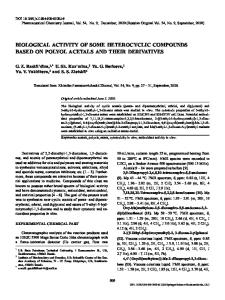An Eco-Friendly Synthesis of Some Novel Chromene-Based Heterocyclic Compounds of Biological Interest
- PDF / 364,838 Bytes
- 8 Pages / 612 x 792 pts (letter) Page_size
- 70 Downloads / 355 Views
n Eco-Friendly Synthesis of Some Novel Chromene-Based Heterocyclic Compounds of Biological Interest E. Mansoura, 1, E. M. Nassara, A. F. El-Farargyb, and F. M. Abdelrazekc aChemistry
Department, Faculty of Women for Arts, Science and Education, Ain Shams University, Cairo, 11767 Egypt bChemistry Department, Faculty of Science, Zagazig University, Zagazig, 44519 Egypt c Chemistry Department, Faculty of Science, Cairo University, Giza, 12613 Egypt Received July 29, 2019; revised September 13, 2019; accepted October 19, 2019
Abstract—The target chromonylchalcone 3-(3-(4-oxo-4H-chromen-3-yl)-acryloyl)-2H-chromen-2-one was synthesized by reacting 3-acetylcoumarin with 3-formylchromone. The chromonylchalcone was reacted with active methylene reagents, thiourea, hydrazines, aromatic amines, and sodium azide to afford new heterocyclic compounds. The newly prepared compounds were screened for their anti-microbial and antiinflammatory activities. Keywords: chromenes, chalcones, pyrazoles, triazoles, pyrimidines, antimicrobial, anti-inflammatory activities DOI: 10.1134/S1068162020040135
INTRODUCTION Benzopyran-2-one (coumarin), benzopyran-4one (chromone), and their derivatives are widely distributed in nature presenting a wide range of biologically active compounds exhibiting cytotoxic, neuroprotective, antimicrobial, anti-fungal, and anti-cancer properties [1]. The two important pyran-2-one (coumarin) and pyran-4-one (chromone) compounds can be used as key precursors in the synthesis of different heterocyclic compounds. Coumarin derivatives are well known as antibacterial, antiviral, insecticidal, anti-inflammatory, and antioxidant agents [2–4]. Chromone derivatives also have their characteristic biological activities, such as anti-inflammatory and anticancer activities; they are useful as antiallergic agents for bronchial asthma [5]. Several studies revealed that chalcones containing chromone and coumarin moieties constitute important members of biologically active compounds. In continuation of our current research aiming to synthesize diverse heterocyclic systems with expected biological importance [6–12], we considered that the combination of a coumarin ring with a chromone and other heterocyclic rings in one entity may enhance their biological activity due to the combined effect of these rings. 3-Acetylcoumarin (I) and 3-formylchromone (II) scaffolds seemed suitable starting materials to fulfill the objective of synthesizing novel chromonyl 1 Corresponding
author: phone: 00201115728866; e-mail: [email protected].
chromenyl chalcone (III), and then some heterocyclic ring systems on this chalcone [12]. RESULTS AND DISCUSSION 3-Acetylcoumarin (I) [13] was reacted with 3-formylchromone (II) [14] in refluxing ethanol catalyzed by 4-N,N-dimethylaminopyridine (DMAP) to afford the new chalcone (III). The IR spectrum of chalcone (III) displayed coumarin and chromone carbonyl groups at νmax 1739 and 1711 cm–1, respectively. The 1H NMR spectrum revealed olefinic protons as two doublets at δ 7.94–7.96 and 8.14–8.16 ppm. Th
Data Loading...











